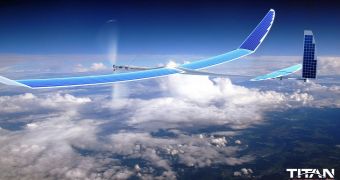Google has acquired Titan Aerospace, maker of solar-powered drones. Facebook has reportedly been showing an interest in this company as well.
The acquisition price hasn’t been revealed, but that’s not exactly a new development when it comes to Google’s deals. Titan Aerospace, which is based in New Mexico, develops jet-sized drones that can fly nonstop for years, which Google says can come in handy to collect images and offer Internet access to remote areas.
Basically, it will help tools such as Maps and Street View, but also the courageous Project Loom that was built to deliver online access to remote areas of the world with the help of balloons.
Google X is still working on the theory that it can create a network of such balloons that connect to a cellphone tower on the ground to provide Internet access to areas that couldn’t possibly get online in other ways.
The technology could even be used to dispatch Internet coverage to regions affected by natural disasters where regular connections are no longer available. The balloons are directed to the desired locations by moving them upwards and downwards to help them reach the necessary air currents.
As per usual, since Facebook has shown an interest in Titan Aerospace, Google wanted to top off any offer that the social network could make. This seems like a very similar story to what happened to Whatsapp, even though Google denied discussing an acquisition with the messaging app.
This time, however, it involves drones – gadgets that are quite controversial. On top of the privacy issue, there are also a lot of troubles from a legal point of view. Amazon, for instance, seeks to start delivering light orders to users with small drones, but has to wait until proper legislation is in place.
On the other hand, the benefit of owning such technologies can be observed quite easily. While Project Loon’s balloons are indeed innovative, they are at the mercy of wind currents. Drones can be handled by humans and are way more resilient when it comes to facing the elements.
“It is still early days, but atmospheric satellites could help bring Internet access to millions of people, and help solve other problems, including disaster relief and environmental damage like deforestation,” said one Google spokesperson.
Titan’s claims indicate that the drones they build can help deliver Internet access of up to one gigabit a second by using special communications equipment, which is already significantly faster than what ISPs in most developed countries offer.

 14 DAY TRIAL //
14 DAY TRIAL //